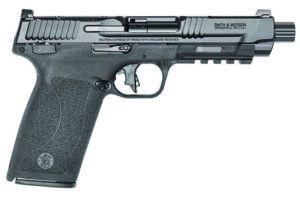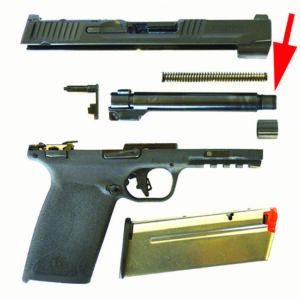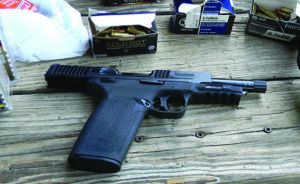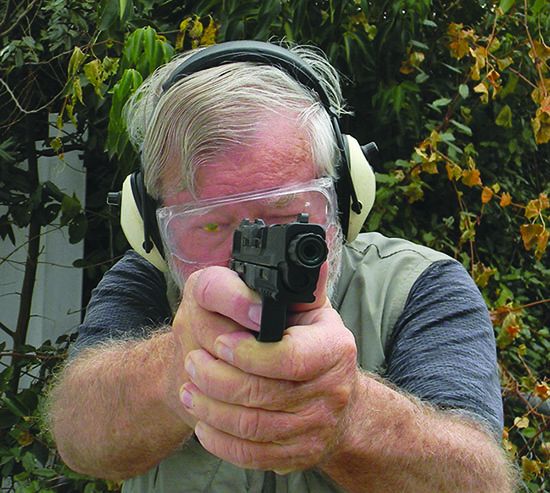The 5.7x28mm cartridge, also called the FN 5.7x28mm or the FN 5.7x28mm NATO, seems more popular than ever, largely due to the introduction of modern handguns such as the FN FiveSeveN and Ruger-5.7. We’ve been interested in the round for a while, reviewing the FiveSeveN in the November 2011 issue (versus the 22 Magnum KelTec PMR-30) and the December 2014 issue (versus the Rock Island Armory Micro Mag Standard 51687 22 TCM) and the Ruger-5.7 in the October 2020 issue (versus the Rock Island Armory TCM044816 22 TCM and the KelTec PMR-30 PMR30BBLK 22 WMR). We also covered the FN PS90 chambered in the round (January 2018) and the 57Center AR57 PDW 5.7x28mm Upper in the March 2011 issue. It seems 5.7x28mm firearms are more affordable and more useful than ever before.
Still, an issue for training with the 5.7x28mm cartridge has been the high cost of ammunition. Fiocchi has made an effort to bring the price of 5.7 down, with 150 rounds of 5.7x28mm currently running about $79 versus as much as $45 per 50-round box not long ago. A box a month in practice is becoming attainable. With this in mind, we matched the Smith & Wesson M&P 5.7 Series 13348 5.7x28mm, $579, against the new Smith & Wesson M&P 22 Magnum Series 13433 22 Magnum, a $599 pistol. The result was one of the more interesting shoot-outs and a lot of ammunition fired in these addictive handguns.
How We Tested
Because some shooters will wish to deploy the pistols for personal defense as well as informal shooting, we tested a number of loads in water jugs, our standard testing material. First up was the 5.7x28mm Fiocchi Hyperformance 40-grain polymer-tipped hollow-point round (57PT40). At 1730 fps, this load penetrated an average of 15.0 inches of water. Expansion averaged 0.455 inch, although there was also some fragmentation. Next up came the Vanguard Outfitters Black Fang loading. This is a wickedly-pointed solid-copper bullet intended to tumble, but not expand or fragment. At 1890 fps, it did tumble, exiting the side of the water jug on all three tries. The Speer Gold Dot bullet at 1835 fps penetrated 18 inches and expanded to 0.302 caliber. This is consistently good penetration that seems to track straight. We also fired an FN-branded load, the SS197SR with a 40-grain V-Max tipped hollow point, the same design as the Fiocchi. We didn’t shoot it in water, but we’d expect the FN load to fragment like the Fiocchi round, with 79 fps more velocity and 22 foot-pounds more energy. A Fiocchi Range Dynamics subsonic FMJ round (57SUB62) with a 62-grain payload wouldn’t operate the S&W pistol consistently, so we didn’t gather data on it.
In the 22 Winchester Magnum Rimfire (WMR) rounds, we tested the CCI Maxi-Mag 30-grain TNT jacketed hollow points (0036). This load broke up in 7 inches of water, exactly as designed. Such performance makes for a potent pest popper. The CCI Maxi-Mag at 1382 fps penetrated 18 inches but did not expand. The Hornady 45-grain Critical Defense ammunition clocked a consistent 1254 fps. Penetration was 14 inches, with consistent expansion to 0.34 caliber. When all is said and done, the 22 Magnum and 5.7x28mm are separated by the 5.7’s energy release into the second water jug with tremendous disruption. For self defense, we would prefer the 9mm Luger to either, based on our extensive testing and practical experience. But the 22 Magnum and 5.7x28mm are each starchy plinkers, with ranges much greater than the 22 LR. However, are these Smith & Wesson platforms good launching pads for these rounds? We think so, as the details below explain.
Smith & Wesson M&P 5.7 Series 13348 5.7x28mm
$579
Gun Tests grade: A
Easy to use and fire accurately. The magazine loader is an excellent design. The magazines are robust and reliable. Recoil and muzzle blast are negligible. While it didn’t make small groups on paper, it hit targets well past common handgun range. The real drawback compared to a 22 LR or the 22 Magnum plinker is ammunition expense.

| Action Type | Internal hammer-fired, gas-operated, locked-breech Tempo barrel system |
| Overall Length | 8.5 in. |
| Overall Height | 5.25 in. |
| Maximum Width | 1.1 in. |
| Weight Unloaded | 26.7 oz. |
| Weight Loaded | 32.3 oz. |
| Barrel | 5.0 in. long, stainless steel, 1:9 twist, muzzle threads @ 1⁄2x28 |
| Slide | Black finish, RMSc optics cut, ambi slide stop, front and rear serrations |
| Slide Retraction Effort | 13.0 lbs. |
| Frame | Full-size black polymer, Picatinny rail |
| Frame Front Strap Height | 2.75 in. |
| Frame Rear Strap Height | 3.75 in. |
| Frame Grip Thickness | 1.1 in. |
| Frame Grip Circumference | 5.4 in. |
| Magazines | (2) 22 round |
| Rear Sight | Drift adjustable, two white dot |
| Front Sight | One white dot |
| Sight Radius | 6.75 in. |
| Trigger Pull Weight | 3.8 lbs. |
| Trigger Span | 2.9 in., flat-face style |
| Safety | Manual lever, left side |
| Warranty | Lifetime Service Policy |
| Telephone | (800) 331-0852 |
| Website | Smith-Wesson.com |
Inexplicably, the cost of the FDE frame color of the M&P 5.7 Series is averaging $669. If you are happy with the black gun, this puts the average price of the 5.7x28mm pistol slightly lower than the 22 Magnum. The pistol will be competitive with the Ruger -5.7 and FN 5.7. We have tested several Military & Police handguns in 30 Super Carry, 380 ACP, 9mm, 40 S&W, 10mm Auto, and 45 ACP. This pistol resembles some of them.
The 5.7x28mm isn’t the most practical cartridge, but it certainly has a following. Of all the 5.7 handguns available, the Smith & Wesson M&P seems the best suited for personal defense and carry use. The cartridge isn’t something you may chamber in a subcompact, and you need sufficient barrel length to develop enough velocity to make the hot 22-caliber worthwhile (the 5.7mm diameter translates to .224 inch). This is a relatively light handgun at 26 ounces and is thin enough for concealed carry. The length and height are larger than most compact carry guns, so this is a service-size handgun, and it handles and operates in a positive manner. No ergonomic concerns came to light.

Among the best features of this centerfire hammer-fired single-action pistol is the M&P 5.7 Smith & Wesson’s 22-round magazine capacity. This gives the pistol a good reserve of ammunition in an emergency. The Military & Police 5.7 is a polymer-frame handgun with an Armornite-coated slide. Smith & Wesson stressed the pistol is designed for reliability, accuracy, and consistency. The true innovation is in the Tempo Barrel System. This is a gas-operated design with a rotating barrel and locked breech operation. Our observations after testing other rotating-barrel systems has been that the rotating barrel may limit recoil and is strong when handling high pressure, while the system demands more lubrication than other types. When the Smith & Wesson Tempo barrel was field-stripped, we discovered the inner barrel was well greased. We recommend maintaining the pistol in this manner.
The pistol has a hammer-fired single-action trigger. We were pleasantly surprised to find the trigger action breaks at a clean 3.8 pounds. The safety, slide lock, and trigger action are very similar to the S&W 22 Magnum with practically the same feel. In the modern era, the barrel is often threaded, and so is this 5.7 pistol. The 1⁄2×28 threaded muzzle provides more versatility. But wait: Can a 5.7 be suppressed? Why yes, Fiocchi offers a 62-grain subsonic (1050 fps factory rating) and Vanguard offers a 55-grain subsonic (1010 fps factory rating). So, the 5.7x28mm with subsonic ammunition may be suppressed.
A flat-face trigger with blade lever is typical of the new generation Smith & Wesson pistol. Not only was trigger compression a crisp 3.8 pounds, reset is sharp. We like this trigger better than the 22 Magnum, although both are good.

Disassembly is less involved than the 22 Magnum. Unload the pistol, then check the chamber again. Using the slide lock/release, lock the slide to the rear, then check the chamber. Run the slide forward, then bring the slide to the rear a quarter inch, and press out the slide lock. Only finger pressure is needed. The slide will run forward off the frame. The recoil assembly and barrel are easily pulled out. The barrel is rotated to remove it from the outer barrel shroud. This system doesn’t seem to accumulate powder ash or jacket material. The pistol, despite the two-piece rotating barrel, is simple enough.
Elsewhere, the grip is a bit long, but it’s thin enough for good hand fit. Recoil is low, very low, so slippage in the hand isn’t a problem. The grip frame is nicely pebbled and not grating as we found on the M&P 10mm. The magazines are easily loaded to about 20 rounds, and most of the testing was done without the final more difficult two rounds. However, the magazine loader supplied with the Smith & Wesson 5.7x28mm pistol is among the simplest and most effective we have used. Everyone could easily load the pistol to full capacity.
The pistol got high marks in handling and ease of use even before it was fired. The rear sight is a simple notch with windage adjustment. The front sight is a steel post with white dot insert.
We fired the pistol with Vanguard Ammunition’s 34-grain loads, American Eagle 40-grain, Fiocchi 36-grain and Fiocchi 40-grain, Fiocchi 62-grain, Speer Gold Dot 40-grain, and FN 40-grain ammunition. This was an expensive amount of ammunition, with most at $40 per box. We paid $50 per box for the Gold Dot, but we’re glad we did. We loaded the magazines and began firing at targets at 7, 12, 15, and 25 yards. We also extended firing to a full magazine at the 50-yard gong. Recoil was present in a bit of a push, similar to the 22 Magnum, and muzzle flash actually seemed less with some loads than the 22 Magnum. With such an ease of loading and operating, the pistol has appeal to those with disability. We fired 200 rounds in just over an hour. The pistol never failed to feed, chamber, fire, or eject during the initial set.
Accuracy was good. In offhand fire, groups were clusters of tiny holes during the fast self-defense portion of the test. We were able to fire as quickly as the trigger reset. We did not have to wait for the muzzle to settle down after its climb during recoil because there was practically no muzzle flip. By whatever standard you wish to apply, the Smith & Wesson 5.7x28mm pistol is a great defensive handgun — if we don’t consider the cartridge — and speed and low recoil are a product of the cartridge as well. The pistol is slightly more effective in fast combat shooting than the 22 Magnum pistol.
The only tie up came at the indoor range when we attempted to fire the Fiocchi heavyweight subsonic. The action refused to cooperate, and the heavy-bullet load would not function. However, the 62-grain loads did function in a Ruger 5.7, save the slide did not lock open on the last shot. Perhaps this is a function of the gas-operated system of the S&W 5.7. The 62-grain bullet running at 960 fps isn’t the type of load likely to function in an unmodified 5.7x28mm handgun. Modification of the recoil spring may result in proper operation, but at the same time, the pistol would beat itself up with full-power loads if they functioned at all. So, if you go the suppressor route, more research is needed. We cannot fault a pistol set up for full-power loads that failed to function with a 62-grain 960 fps load.
Firing the pistol for accuracy from a solid benchrest is comfortable enough. Recoil is slight. Accuracy isn’t what we hoped for with the 40-grain loads from FN, Fiocchi, and Speer. All were accurate enough for defense, and all went into a five-shot group at 25 yards averaging 2.5 inches, with the FN 40-grain load being more accurate by a slight margin at 2.3 inches. This is par for the course with 5.7 pistols we have tested previously.
Our Team Said: We like the Smith & Wesson M&P 5.7x28mm pistol. It is reliable, easy to load, easy to field-strip and service, and doesn’t demand a great deal of maintenance. It would make a good choice for anyone who has difficulty loading a pistol magazine (by virtue of a praiseworthy magazine loader), racking a slide, or handling recoil. Accuracy is pedestrian for such a large handgun perhaps, but adequate.
| 5.7x28MM RANGE DATA | |
| Vanguard Black Fang 34-grain Solid Copper BFD-V57 | Smith & Wesson M&P 5.7 Series |
| Average Velocity | 1890 fps |
| Muzzle Energy | 270 ft.-lbs. |
| Smallest Group | 2.9 in. |
| Average Group | 2.8 in. |
| Speer Gold Dot 40-grain HP | Smith & Wesson M&P 5.7 Series |
| Average Velocity | 1835 fps |
| Muzzle Energy | 299 ft.-lbs. |
| Smallest Group | 2.0 in. |
| Average Group | 2.5 in. |
| Fiocchi Hyperformance 40-grain 57PT40 THP | Smith & Wesson M&P 5.7 Series |
| Average Velocity | 1730 fps |
| Muzzle Energy | 266 ft.-lbs. |
| Smallest Group | 2.2 in. |
| Average Group | 2.5 in. |
| FN SS197SR 40-grain V-Max THP | Smith & Wesson M&P 5.7 Series |
| Average Velocity | 1809 fps |
| Muzzle Energy | 291 ft.-lbs. |
| Smallest Group | 1.9 in. |
| Average Group | 2.3 in. |
Written and photographed by Gun Tests Staff, using evaluations from Gun Tests Team members. GT


























I have the smith 5.7 and love it. Thanks for the testing.